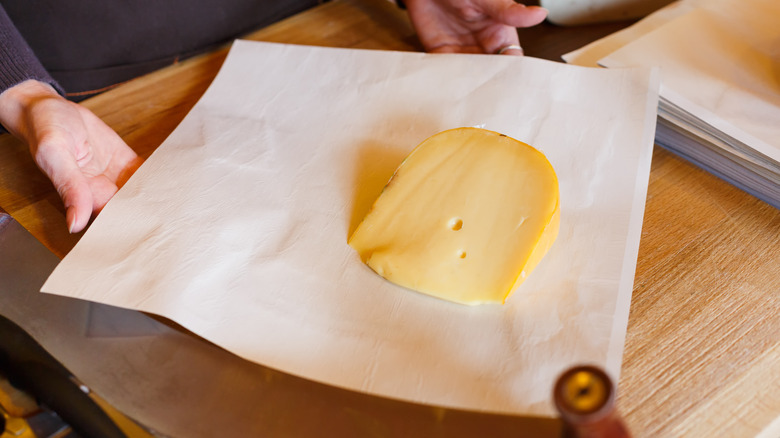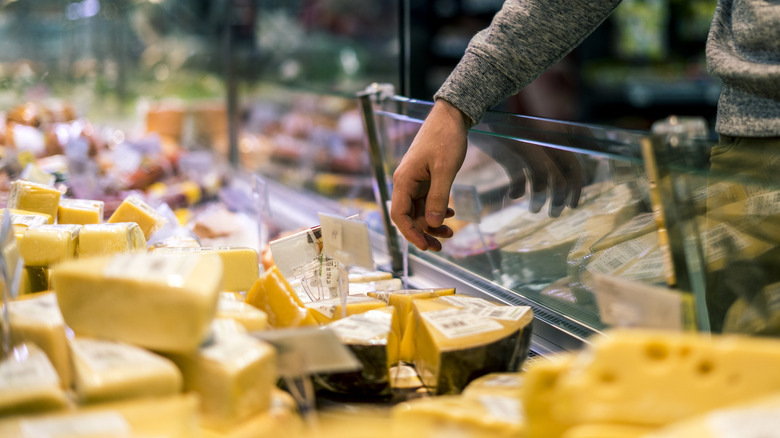The Ammonia Problem With Wrapping Cheese In Plastic
We may receive a commission on purchases made from links.
If you're the type who gets a rush when you're approaching the cheese counter, you're not alone. Americans love to eat cheese in all of its forms. From snacking on crackers to building charcuterie boards, Americans each eat around 40 pounds of cheese per year (according to Statista).
And in addition to eating cheese, people spend a lot of time reading about cheese, planning what to buy based on reviews and recommendations, and coming up with recipes that use cheese. Perhaps because everyone's so enthusiastic about cheese eating, they don't spend nearly enough time thinking about how to store cheese when it's leftover — obviously, the plan is to eat it all.
Buying even a few ounces or grams of good quality cheeses is an investment, according to Culture, and you don't want to throw away any of your hard-earned money letting it go bad. So take a few minutes to learn about the best way to store it; you'll thank yourself every time you have a bite of yummy, fresh-tasting cheese.
Cheese is alive
Cheese is made, in part, by inoculating milk with good bacteria, which are tiny living cells that break down the lactic acid in the milk (per the National Library of Medicine). Basically, your cheese is alive, and you should never wrap your cheese at home in plastic wrap, as it is "a full barrier, and cheese needs air and humidity to breathe," Joey Wells, Global Senior Coordinator for Specialty Cheese Product Innovation and Development at Whole Foods Market, said to Eat This, Not That!.
Yes, when you buy cheese at the store — even many of the fancy specialty cheese stores — you'll get your pieces packaged in plastic wrap. This is meant to be very temporary, however, and you should re-wrap your cheese in cheese paper, butcher paper, or even wax paper when you get it home, according to Food & Wine.
There are countless other easy and convenient uses for plastic wrap. But if you leave your cheese wrapped in plastic for too long, it can take on some of the flavor of the plastic, which is especially detected in delicately-flavored, fresh cheeses. Plastic wrap will also trap ammonia, a natural byproduct of the good bacteria living its best life munching on lactic acid in your cheese. When your cheese is wrapped in something more breathable, the ammonia can escape. But with plastic wrap, the ammonia builds up inside the package and can ruin the flavor of the cheese, according to Epicurious.
Treat your cheese tenderly
If you buy a piece of cheese that's wrapped in plastic wrap, or you wrapped a piece of cheese yourself unknowingly and it smells strongly like ammonia, you can potentially salvage it by leaving it out unwrapped for an hour or so to let the ammonia dissipate, according to Epicurious. If it still smells like window cleaner after that, however, you should toss the offending fromage.
If you buy cheese in a supermarket, you won't have much of a say in what your cheese is wrapped in, although some cheesemakers use cheese paper or seal their wares in wax. In this case, just remove the plastic wrap when you get home and replace it with parchment paper, or order some cheese paper if you buy a lot of cheese. If you're shopping at a specialty foods store or a grocer with a wide selection, such as the Whole Foods cheese counter, you can ask the cheesemonger to cut you a fresh piece of whatever looks good, and they'll wrap it in the proper paper.
Once you have your cheese in a breathable bundle, store it in the fridge in the vegetable crisper drawers. While there are other spaces designed for deli meats and cheeses in your refrigerator, artisanal cheeses prefer the lower drawers, according to Martha Stewart, because they have more humidity and will maintain a constant temperature of around 35 F.


